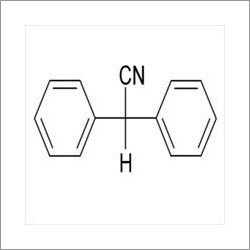About 1,1 डà¥à¤«à¥à¤¨à¤¿à¤² à¤à¤¸à¥à¤à¥à¤¨à¤¿à¤à¥à¤°à¤¾à¤à¤²
| Name of Product | Diphenyl Acetonitrile |
| CAS No | 86-29-3 |
| Formula | C14H11N |
| IUPAC Name | 2,2-diphenylacetonitrile |
|
|
|
|
|
|
| InChI | InChI=1S/C14H11N/c15-11-14(12-7-3-1-4-8-12)13-9-5-2-6-10-13/h1-10,14H |
|
|
|
|
|
|
| InChI Key | NEBPTMCRLHKPOB-UHFFFAOYSA-N |
|
|
|
|
|
|
| Canonical SMILES | C1=CC=C(C=C1)C(C#N)C2=CC=CC=C2 |
|
|
|
|
|
|
| EC Number | 201-662-5 |
|
|
|
|
|
|
| UNII | QK4W106TKU |
|
|
|
|
|
|
|
|
|
|
|
|
|
|
| Other name / synonyms | DIPHENYLACETONITRILE |
| 86-29-3 |
| 2,2-diphenylacetonitrile |
| Dipan |
| Diphenatrile |
| Benzhydrylcyanide |
| benzhydryl cyanide |
| Acetonitrile, diphenyl- |
| Diphenylmethylcyanide |
| Benzyhydrylcyanide |
| Benzeneacetonitrile, alpha-phenyl- |
| USAF KF-13 |
| Diphenylmethyl cyanide |
| Difenylacetonitril |
| Diphenyl-alpha-cyanomethane |
| Benzeneacetonitrile, .alpha.-phenyl- |
| alpha-Phenylphenylacetonitrile |
| alpha-Phenylbenzeneacetonitrile |
| Caswell No. 396 |
| alpha-Phenylbenzylcyanide |
| alpha-Cyanodiphenylmethane |
| Difenylacetonitril [Czech] |
| .alpha.-Phenylbenzylcyanide |
| NSC 130268 |
| Diphenyl-.alpha.-cyanomethane |
| .alpha.-Phenylphenylacetonitrile |
| NEBPTMCRLHKPOB-UHFFFAOYSA-N |
| EINECS 201-662-5 |
| EPA Pesticide Chemical Code 037901 |
| BRN 1911160 |
| AI3-17436 |
| DSSTox_CID_539 |
| WLN: NCYR&R |
| DSSTox_RID_75648 |
| DSSTox_GSID_20539 |
| CAS-86-29-3 |
| diphenyl-acetonitrile |
| Diphenyl acetonitrile |
| PubChem21436 |
| AC1L1NEV |
| AC1Q4QPZ |
| 2,2-diphenylethanenitrile |
| alpha-Phenylbenzyl cyanide |
| 2,2-diphenyl-acetonitrile |
| UNII-QK4W106TKU |
| .alpha.-Cyanodiphenylmethane |
| TimTec1_003810 |
| QK4W106TKU |
| KSC448E1T |
| SCHEMBL181005 |
| ACMC-209q99 |
| 112127_ALDRICH |
| NSC884 |
| CHEMBL3185477 |
| 42690_FLUKA |
| CTK3E8219 |
| NSC-884 |
| MolPort-001-781-522 |
| .alpha.-Phenyl-benzeneacetonitrile |
| HMS1544N04 |
| Tox21_201556 |
| Tox21_302854 |
| ANW-38299 |
| AR-1I6075 |
| NSC130268 |
| STK700770 |
| ZINC03860898 |
| AKOS000120009 |
| AM90235 |
| LS-7365 |
| LS40574 |
| MCULE-5798396210 |
| NSC-130268 |
| RTR-026880 |
| NCGC00249068-01 |
| NCGC00256362-01 |
| NCGC00259105-01 |
| AC-13544 |
| AJ-46077 |
| AK114697 |
| AN-42339 |
| BP-12820 |
| CJ-10900 |
| KB-50140 |
| OR034344 |
| ST052000 |
| TL806381 |
| AB1002708 |
| TR-026880 |
| D0261 |
| FT-0625250 |
| FT-0637918 |
| ST24027252 |
| AE-641/03255011 |
| 3B4-1173 |
| BRD-K12971880-001-01-6 |
| A0770/0036009 |
| InChI=1/C14H11N/c15-11-14(12-7-3-1-4-8-12)13-9-5-2-6-10-13/h1-10,14 |
Applications and Benefits1,1 Diphenyl Acetonitrile is a trusted intermediate for pharmaceutical manufacturing and organic synthesis. Its high purity and stability make it vital for producing complex molecules in the pharmaceutical, agrochemical, and specialty chemical industries. The compounds distinct structure enables efficient integration into multi-step synthesis processes, providing consistency and reliability in end products.
Quality, Safety, and CompliancePackaged in fiber drums or bags to guarantee both purity and safe transportation, 1,1 Diphenyl Acetonitrile is classified as an organic intermediate and nitrile compound. It is not regulated by UN dangerous goods codes, simplifying logistics and storage. Despite its stability, proper handling and personal protection are essential to avoid irritation to skin, eyes, and respiratory system.
Storage and Shelf Life GuidelinesTo maintain stability and maximum shelf life of 36 months, store 1,1 Diphenyl Acetonitrile in a cool, dry, and well-ventilated area, away from light and incompatible materials. Keeping the product sealed until use prevents contamination, while adherence to recommended conditions preserves its chemical integrity and consistent performance.
FAQs of 1,1 Diphenyl Acetonitrile:
Q: How should 1,1 Diphenyl Acetonitrile be stored to ensure maximum stability?
A: This compound should be stored in a cool, dry, well-ventilated area, away from direct light and incompatible substances. Adhering to these conditions preserves its stability and extends its shelf life to 36 months from the date of manufacture.
Q: What are the main applications of 1,1 Diphenyl Acetonitrile?
A: 1,1 Diphenyl Acetonitrile serves primarily as an intermediate in the synthesis of pharmaceuticals, specialty organic compounds, and agrochemicals due to its high purity and unique structural properties.
Q: When should personal protective equipment be used while handling this compound?
A: Personal protective equipmentsuch as gloves, safety goggles, and respiratory protectionshould be used at all times while handling 1,1 Diphenyl Acetonitrile to minimize the risk of skin, eye, or respiratory tract irritation.
Q: Where is this product typically manufactured and supplied from?
A: 1,1 Diphenyl Acetonitrile is manufactured and exported from India, with bulk quantities available for international supply through manufacturers and suppliers.
Q: What are the benefits of using this compound in organic synthesis?
A: The compounds high purity and reactivity streamline multi-step organic syntheses, leading to higher yields and consistent results, which is particularly advantageous in pharmaceutical and agrochemical production.
Q: How is 1,1 Diphenyl Acetonitrile typically packaged for shipment?
A: It is commonly packaged in 25 kg fiber drums or bags, but can also be customized based on customer requirements to ensure safe handling and transportation.

